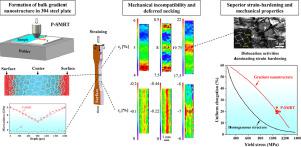International Journal of Plasticity ( IF 9.4 ) Pub Date : 2022-05-08 , DOI: 10.1016/j.ijplas.2022.103336 Y.T. Sun 1, 2 , X. Kong 1, 2 , Z.B. Wang 1

|
Spatially gradient microstructures have shown a promising application in enhancing strength-ductility synergy of engineering metals such as austenitic stainless steels. However, existing approaches are limiting in producing a thick gradient nanostructured (GNS) layer with a high strengthening capability, and the underlying deformation mechanisms are still not clear in GNS austenitic stainless steels. In this work, we developed a new approach, i.e., plate surface mechanical rolling treatment, to produce a bulk gradient nanostructure in a 304 stainless steel plate of ∼1.90 mm in thickness. Uniaxial tensile tests revealed that an ultra-high yield strength of ∼1073 MPa with a considerable uniform elongation of ∼21% was achieved in the GNS sample. Subsequently, the evolutions of microstructure, phase, microhardness, and local strain distribution were systematically studied in the GNS plate during tensile tests. The results demonstrated that the mechanical incompatibilities, relating with the gradient microstructure and martensite-enclosing-austenite domains, contribute to an extra strain-hardening capability, leading to the outstanding strength-ductility synergy in the GNS 304 stainless steel. Furthermore, analyses based on experimental observations and theoretical calculations revealed that dislocation activities, instead of deformation-induced martensite transformation, microstructure refinement, and twinning, play a dominant role in the strain-hardening mechanisms of the GNS plate during tension.
中文翻译:

具有梯度纳米结构的304不锈钢板的优越力学性能和变形机制
空间梯度微结构在提高工程金属(如奥氏体不锈钢)的强度-延展性协同作用方面显示出有前景的应用。然而,现有方法在生产具有高强化能力的厚梯度纳米结构 (GNS) 层方面受到限制,并且 GNS 奥氏体不锈钢的潜在变形机制仍不清楚。在这项工作中,我们开发了一种新方法,即板表面机械滚压处理,以在厚度约为 1.90 毫米的 304 不锈钢板中产生体积梯度纳米结构。单轴拉伸试验表明,在 GNS 样品中实现了约 1073 MPa 的超高屈服强度和约 21% 的相当均匀伸长率。随后,显微组织、相、显微硬度的演变,在拉伸试验期间,系统地研究了 GNS 板中的局部应变分布。结果表明,与梯度微观结构和马氏体包围奥氏体域相关的机械不相容性有助于额外的应变硬化能力,从而导致 GNS 304 不锈钢具有出色的强度-延展性协同作用。此外,基于实验观察和理论计算的分析表明,位错活动在 GNS 板在拉伸过程中的应变硬化机制中起主导作用,而不是形变诱发的马氏体转变、显微组织细化和孪晶。与梯度微观结构和马氏体包围奥氏体域相关,有助于额外的应变硬化能力,导致 GNS 304 不锈钢具有出色的强度-延展性协同作用。此外,基于实验观察和理论计算的分析表明,位错活动在 GNS 板在拉伸过程中的应变硬化机制中起主导作用,而不是形变诱发的马氏体转变、显微组织细化和孪晶。与梯度微观结构和马氏体包围奥氏体域相关,有助于额外的应变硬化能力,导致 GNS 304 不锈钢具有出色的强度-延展性协同作用。此外,基于实验观察和理论计算的分析表明,位错活动在 GNS 板在拉伸过程中的应变硬化机制中起主导作用,而不是形变诱发的马氏体转变、显微组织细化和孪晶。











































 京公网安备 11010802027423号
京公网安备 11010802027423号